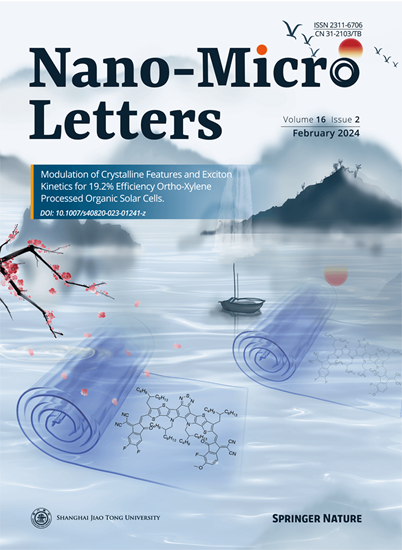在镁离子电池中用于高容量Mg2+离子存储的纳米锐钛矿TiO2与暴露(001)面。
IF 36.3
1区 材料科学
Q1 Engineering
引用次数: 0
摘要
由于Mg2+在锐钛矿TiO2晶格中具有较高的扩散能垒,因此微尺寸锐钛矿TiO2作为镁离子电池正极材料的性能较差。本文中,我们报告了纳米锐钛矿TiO2暴露在(001)面,与微尺寸样品相比,由于界面Mg2+离子存储,容量增加了一倍。第一性原理计算表明,Mg2+在(001)面的扩散能垒明显低于体相和(100)面的扩散能垒,Mg2+在(001)面的吸附能也明显低于(100)面的吸附能,这保证了(001)面的界面Mg2+存储能力较好。此外,暴露的锐钛矿TiO2 (001) facet在Mg-Li双盐电解质中的容量为312.9 mAh g-1,明显高于Li盐电解质中的234.3 mAh g-1。Mg2+在(001)表面的吸附能远低于Li+在(001)表面的吸附能,表明Mg2+离子在(001)表面的界面存储更有利。这些结果表明,控制纳米晶体的晶面可以有效地提高多价离子的界面存储。该工作为大容量存储系统的合理设计提供了有价值的指导。本文章由计算机程序翻译,如有差异,请以英文原文为准。
Nanosized Anatase TiO2 with Exposed (001) Facet for High-Capacity Mg2+ Ion Storage in Magnesium Ion Batteries.
Micro-sized anatase TiO2 displays inferior capacity as cathode material for magnesium ion batteries because of the higher diffusion energy barrier of Mg2+ in anatase TiO2 lattice. Herein, we report that nanosized anatase TiO2 exposed (001) facet doubles the capacity compared to the micro-sized sample ascribed to the interfacial Mg2+ ion storage. First-principles calculations reveal that the diffusion energy barrier of Mg2+ on the (001) facet is significantly lower than those in the bulk phase and on (100) facet, and the adsorption energy of Mg2+ on the (001) facet is also considerably lower than that on (100) facet, which guarantees superior interfacial Mg2+ storage of (001) facet. Moreover, anatase TiO2 exposed (001) facet displays a significantly higher capacity of 312.9 mAh g-1 in Mg-Li dual-salt electrolyte compared to 234.3 mAh g-1 in Li salt electrolyte. The adsorption energies of Mg2+ on (001) facet are much lower than the adsorption energies of Li+ on (001) facet, implying that the Mg2+ ion interfacial storage is more favorable. These results highlight that controlling the crystal facet of the nanocrystals effectively enhances the interfacial storage of multivalent ions. This work offers valuable guidance for the rational design of high-capacity storage systems.
求助全文
通过发布文献求助,成功后即可免费获取论文全文。
去求助
来源期刊

Nano-Micro Letters
NANOSCIENCE & NANOTECHNOLOGY-MATERIALS SCIENCE, MULTIDISCIPLINARY
CiteScore
32.60
自引率
4.90%
发文量
981
审稿时长
1.1 months
期刊介绍:
Nano-Micro Letters is a peer-reviewed, international, interdisciplinary, and open-access journal published under the SpringerOpen brand.
Nano-Micro Letters focuses on the science, experiments, engineering, technologies, and applications of nano- or microscale structures and systems in various fields such as physics, chemistry, biology, material science, and pharmacy.It also explores the expanding interfaces between these fields.
Nano-Micro Letters particularly emphasizes the bottom-up approach in the length scale from nano to micro. This approach is crucial for achieving industrial applications in nanotechnology, as it involves the assembly, modification, and control of nanostructures on a microscale.
 求助内容:
求助内容: 应助结果提醒方式:
应助结果提醒方式:


